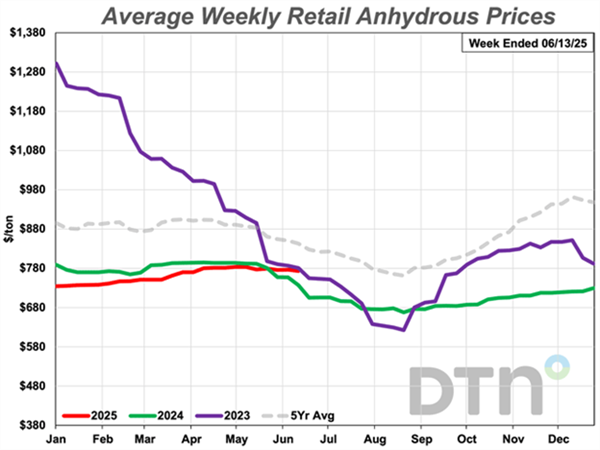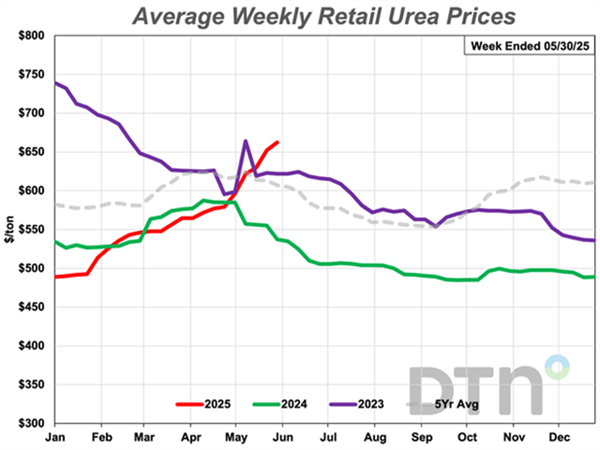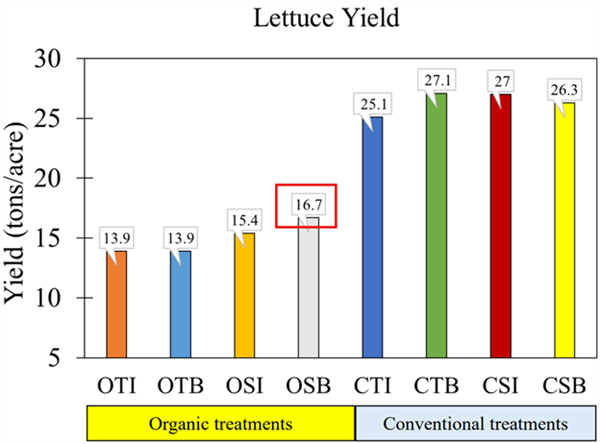
Fertilizer prices have been relatively stable in 2025 and close to 2024 prices. In the last four to six weeks fertilizer prices have been increasing. Based on recent reports, prices for seven major fertilizers are now trending higher than a year ago. Price increases compared to 2024 are shown in Table 1. Recent market prices for the same seven fertilizers are listed in Table 2.

Table 1. Percent fertilizer price increases compared to 2024. Source: Quinn, 2025b.

Table 2. Recent fertilizer prices, US$/Ton. Source: Quinn, 2025b.
Anhydrous ammonia (82% nitrogen (N)) is a common measure of the fertilizer market since most N containing fertilizers are based on anhydrous ammonia in manufacturing. Price trends for anhydrous ammonia are presented in Figure 1 comparing prices for 2023-2025 with a five-year average.

Figure 1. Average weekly retail anhydrous ammonia (82% nitrogen) prices in 2023-2025
and five-year average, US$/Ton. Source: Quinn, 2025a
One concern in the fertilizer industry currently is associated with urea (46% N), which has been steadily increasing in price over the past six months (Figure 2). These concerns have recently been exacerbated by the conflict in the Middle East that has closed urea production in Iran.

Figure 2. Average weekly retail urea fertilizer prices in 2025, US$/Ton. Source: Quinn,
2025a
In 2024, Iran was the third largest global producer of urea. Annual urea export volumes from Iran have been around 4.5 million (M)tons, which is about the same as China’s urea export production. Industry experts estimate urea production of Iran to be approximately 8.9 M tons/year. Their major international clients have included Turkey, Brazil, and Argentina. The Iranians sell urea to many other countries as well (Hanrahan, 2025).
In recent years, the United States has not been purchasing Iranian urea. But the disruption in anhydrous ammonia and urea production from a major producer such as Iran, can be expected to create disruptions in the global fertilizer market.
This happened with N fertilizers in 2022 following the Russian invasion of Ukraine, after which global N fertilizer prices rapidly increased. After about 18 months fertilizer prices stabilized (Figures 1 and 2).
With the instability and uncertainties that are currently being experienced with Middle Eastern conflicts, it is important to watch global fertilizer markets and expect some changes.
References:
Hanrahan, R. 2025.Iran-Israel Conflict Adds Uncertainty to Fertilizer Market. University ofIllinois Farm Policy News Summary, 17 June 2025. https://farmpolicynews.illinois.edu/2025/06/iran-israel-conflict-adds-uncertainty-to-fertilizer-market/
Quinn, R. 2025a. DTNRetail Fertilizer Trends: Urea, UAN28 Lead Major Fertilizer Prices Higher.Progressive Farmer, DTN. 4 June 2025.
Quinn, R. 2025b. DTNRetail Fertilizer Trends: All Retail Fertilizers See Only Slight Price Movesfor First Time This Spring. Progressive Farmer, DTN. 18 June 2025. https://www.dtnpf.com/agriculture/web/ag/crops/article/2025/06/18/retail-fertilizers-see-slight-price
Frost and freeze damage affect countless fruit and vegetable growers leading to yield losses and occasionally the loss of the entire crop. Frost damage occurs when the temperature briefly dips below freezing (32°F).With a frost, the water within plant tissue may or may not actually freeze, depending on other conditions. A frost becomes a freeze event when ice forms within and between the cell walls of plant tissue. When this occurs, water expands and can burst cell walls. Symptoms of frost damage on vegetables include brown or blackening of plant tissues, dropping of leaves and flowers, translucent limp leaves, and cracking of the fruit. Symptoms are usually vegetable specific and vary depending on the hardiness of the crop and lowest temperature reached. A lot of times frost injury is followed by secondary infection by bacteria or opportunist fungi confusing with plant disease.
Most susceptible to frost and freezing injury: Asparagus, snap beans, Cucumbers, eggplant, lemons, lettuce, limes, okra, peppers, sweet potato
Moderately susceptible to frost and freezing injury: Broccoli, Carrots, Cauliflower, Celery, Grapefruit, Grapes, Oranges, Parsley, Radish, Spinach, Squash
Least susceptible to frost and freezing injury: Brussels sprouts, Cabbage, Dates, Kale, Kohlrabi, Parsnips, Turnips, Beets
More information:
My name is Mazin Saber, and I serve as an Associate in Extension specializing in Weed Management at the School of Plant Sciences, University of Arizona/Yuma County Cooperative Extension, based at the Yuma Agricultural Center. My work focuses on developing innovative site-specific weed management strategies tailored to specialty crop systems in desert agriculture, aiming to establish effective and sustainable weed control programs. I currently lead a new weed control research initiative at the Yuma Agricultural Center.
My academic background includes a Bachelor’s degree in Agricultural Mechanization and a Master’s degree in Agronomy from the University of Basrah, Iraq. I also hold an M.E., and Ph.D. in Agricultural and Biological Engineering from the University of Florida, where my doctoral research focused on designing automated mechanical intra-row weed control system for row crops.
Previously, my research has involved quantitative assessment of crop water-use and salt balance in the Lower Colorado River region. By utilizing advanced tools such as Eddy Covariance to measure evapotranspiration across 14 major crops over multiple seasons on commercial farming, I have contributed to improving water use efficiency and enhancing the sustainability and competitiveness of desert agriculture.
As I build my weed management program, I am conducting an assessment survey to identify the most pressing weed management challenges. Your feedback is crucial to ensure this program meets your needs. Please take a few minutes to complete the survey using the link below.
https://uarizona.co1.qualtrics.com/jfe/form/SV_4Od09r4hPLThLz8
I am available for any discussions about weed issues on your farm and I am happy to arrange field visits or ride-alongs to better understand your specific challenges. Please feel free to reach out to me directly.
We conducted a series of trials during Fall 2024 and Spring 2025 to evaluate the efficacy of organic-approved insecticides currently on the market. While some of the products evaluated were found to be effective, the results of our studies demonstrated that most of these marketed organic-approved insecticides had marginal to no efficacy against common insect pests that attack vegetable crops in the desert. When the insecticides were evaluated alone, the highest label rate was used; when assessed as a mixture of two products, each product was applied at half of the label rate.
Below, we list the insecticides that resulted in some level of suppression for each insect pest.
1- Brassica
Pale stripes flea beetle: Biolink (insect & bird repellent), Insect & Bird repellent mix with Pyganic, and Entrust mix with M-Pede can provide measurable suppression of pale stripe flea beetle. Multiple applications may be required to enhance seedling protection.
Whitefly: M-Pede performed best against whiteflies on brassicas, but Surround, Pyganic, and BotaniGard can also provide some marginal level of suppression. It is best to apply Surround and BotaniGard when the plants are small. Dense foliage prevents insecticide droplets from reaching the lower leaves, where most whiteflies are located on the plants.
Diamondback moth and Beet armyworms: XenTari, DiPel, Entrust, a tank mix of DiPel and Pyganic, or XenTari and Pyganic are the most effective options for controlling diamondback moth and beet armyworms. Starting with XenTari in a rotation program can lead to greater suppression of diamondback moths.
Green peach aphid: Aza-Direct can provide measurable (greater than 50% reduction) green peach aphid suppression on broccoli. Because Aza-Direct works as a growth regulator, it is recommended to apply it early in the season to allow the product sufficient time to work and enhance its efficacy.
2- Lettuce
Green peach aphid: Aza-Direct and M-Pede exhibited variable performance when applied to broccoli or lettuce. Aza-Direct performed better at controlling green peach aphid in broccoli, but M-Pede provided the greatest (>50% suppression) green peach aphid suppression in lettuce.
Thrips: Entrust can provide excellent (>90%) control of thrips nymphs and adults. In our studies, other bioinsecticides, such as Gargoil and Aza-Direct, also resulted in thrips suppression of approximately 40% and 50%, respectively. In a rotation program, Aza-Direct and/or Gargoil can be applied at the beginning of the season when thrips populations are low, and thrips injuries are less problematic.
Bioinsecticides and their active ingredients

Improving crop yields through sustainable practices remains a key goal for agricultural research, particularly in regions facing environmental constraints like desert conditions. Biostimulants, products known to enhance plant growth, nutrient uptake, and resilience against environmental stress, offer potential benefits for organic agriculture, especially when integrated with precision irrigation techniques. This study, conducted at the Yuma Agricultural Center (University of Arizona) during the Fall 2024–Spring 2025 growing seasons, evaluated the effects of biostimulant combined with sensor-based irrigation scheduling on iceberg lettuce production under organic and conventional systems. The experimental design included four treatments each for organic and conventional systems, which combined traditional irrigation, sensor-based irrigation, and biostimulant applications.
Results indicated clear distinctions between organic and conventional lettuce systems in response to biostimulant treatments. In organic fields, the integration of biostimulant with sensor-based irrigation (OSB) achieved the highest yield, approximately 16.7 tons per acre. This represented a 20% improvement over organic treatments without sensor-based scheduling (OTI and OTB, 13.9 tons per acre) and an 8.4% increase over sensor-based irrigation without biostimulant (OSI, 15.4 tons per acre). These yield differences highlight the synergistic effect of combining biostimulant with precise irrigation water management techniques in an organic lettuce production system, potentially due to enhanced soil nutrient availability, improved root growth, and optimized water uptake. Conversely, conventional treatments yielded consistently high production across all variations, averaging around 27 tons per acre, with no measurable yield enhancement from adding biostimulant. This may indicate that conventional systems already operating at optimal nutrient and irrigation levels have limited potential for further yield improvement through biostimulant use.
These findings emphasize that biostimulant suggestively enhanced yield in organic lettuce production only when combined with sensor-based irrigation management but offered negligible benefits under conventional farming conditions. The outcomes suggest potential economic and environmental benefits for organic producers adopting integrated management practices involving biostimulant and sensor-based irrigation. Figure 1 provides detailed comparisons of yields across treatments, emphasizing the advantage of coupling biostimulant with sensor-based irrigation in organic systems at the Yuma Agricultural Center.

Figure 1. Lettuce yield: Organic Field: Organic sensor-based irrigation + biostimulant
(OSB), Organic traditional-based irrigation (OTI), Organic traditional-based irrigation +
biostimulant (OTB), and Organic sensor-based irrigation (OSI); Conventional Field:
Conventional sensor based irrigation + biostimulant (CSB), Conventional traditional-based
irrigation (CTI), Conventional traditional-based irrigation + biostimulant (CTB), and
Conventional sensor-based irrigation (CSI) at the Valley Research Center, University of
Arizona, Yuma Agricultural Center, Yuma, Arizona.
Results of pheromone and sticky trap catches can be viewed here.
Corn earworm: CEW moth counts remain at low levels in all areas, well below average for this time of year.
Beet armyworm: Trap increased areawide; above average compared to previous years.
Cabbage looper: Cabbage looper counts decreased in all areas; below average for this time of season.
Diamondback moth: DBM moth counts decreased in most areas. About average for this time of the year.
Whitefly: Adult movement beginning at low levels, average for early spring.
Thrips: Thrips adult counts reached their peak for the season. Above average compared with previous years.
Aphids: Aphid movement decreased in all areas; below average for late-March.
Leafminers: Adults remain low in most locations, below average for March.